
I ought to say something at this point about Heathkit, a marvelous company that, until 1991, manufactured kits that allowed hobbyists to construct various sorts of electronic devices. My major Heathkit projects were my first amateur radio transmitter, the DX-20 discussed above, and then later a second transmitter, a Heathkit Apache. In addition, my first personal computer was a Heathkit, an IBM clone called the Z-150, built after the Heathkit line was purchased by Zenith Data Systems. Click the next link to see a great web page on Heathkit. You can read more on that site about the specific Heathkit devices I built: The DX-20 and the Apache.
I fired up my rig on April 12, 1961, and called "CQ" numerous times on the 40-meter band, without getting any replies. Note 1 Of course, a 50-watt Novice Morse code signal doesn't make much of an impression, especially at a code speed of only five words per minute (what it had taken me to pass the Novice exam). But when I continued the next day, I quickly got a reply from station K9IKV/1, which had a powerful signal. The "K9" prefix doesn't mean he was a dog. Radio stations in the United States, both commercial and amateur, are assigned calls that start with a "K" or "W". This is then followed by a number indicating the general location of the station. Region "9" indicated that K9IKV was licensed in Wisconsin, Illinois, or Indiana. But the "/1" at the end indicated that the station was at the time being operated in one of the five New England states. That was fairly obvious given his powerful signal - he had to be nearby. And so began our "conversation", which I put in quotes because it was rather tedious in Morse code at a rate of about five words per minute. I noted, "I am a student at MIT." He replied, "I am also a student at MIT." OK, so he was not just close, he was really close. I added, "I am in Baker House." He said, "I am also in Baker House, room 243." His name proved to be Andy Munster. After a radio contact, operators usually exchange post cards, called "QSL" cards, confirming the contact. These usually have a station's call sign in large letters, with blanks to be filled in giving the details of the transaction (date and time, frequency used, type of modulation, signal strength, and so on). At the conclusion of our conversation, I walked down the hall, and Andy and I exchanged our QSL cards in person. But there's more. Andy, it developed, also had a dipole antenna, strung across the other (eastern) indentation in Baker House. Our antennas were virtually end to end, probably separated by less than 30 meters. In theory, dipole antennas don't radiate much energy off their ends, but these were so close that they had a powerful connection.
I then purchased a second Heathkit transmitter, an Apache TX-1. This was a much more complex assembly job than the DX-20. I constructed it working evenings over the course of a summer job at the IBM Thomas J. Watson Research Center in Yorktown Heights, New York. The technology of the time was still vacuum tubes, of course. I ultimately mounted that transmitter and my SX-100 receiver on a surplus relay rack I purchased at Eli Heffron's Scrap Electronics store in Cambridge. The picture below shows what it looked like. The receiver is on top, and the transmitter on bottom, with a mechanical digital clock mounted in the center panel. The clock was always set on Greenwich Mean Time ("GMT"), a worldwide standard for ham radio operators. 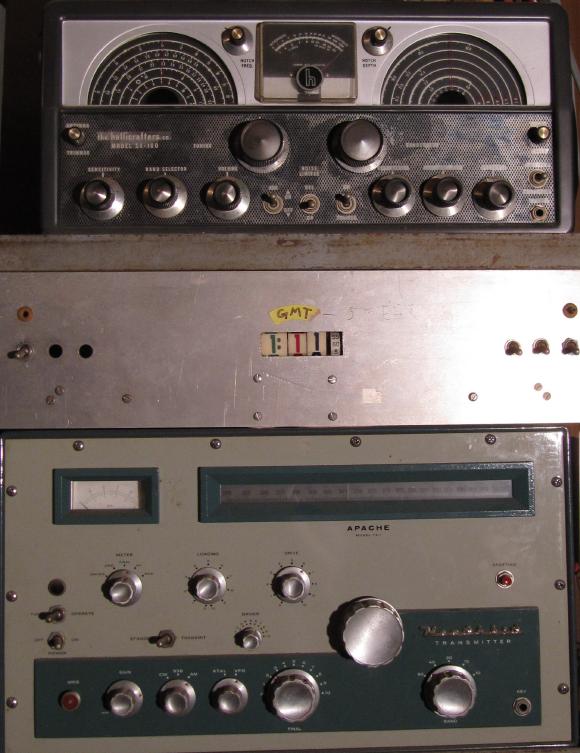 While at MIT, I also joined the MIT Radio Society, America’s oldest college amateur station, call letters W1MX. There I could use a transmitter running a kilowatt of power into the final amplifier, the maximum legal power possible in amateur radio at the time. When I called, people answered. Note 3 In 1968, while I was working on my Ph.D. thesis in the field of Artificial Intelligence ("AI"), Richard Greenblatt wrote a chess-playing program called "Mac Hack VI", which was probably the best chess program of that era. I brought my ham radio rig in to the AI lab, which allowed the Greenblatt's program to play several chess games against another computer program at the ETH, in Zürich, Switzerland (the "Eidgenössische Technische Hochschule", in English the "Swiss Federal Institute of Technology", sort of the Swiss equivalent of MIT). This was very likely the first time that amateur radio had ever been used to play a chess game between two computers. You can read about these games, in great detail, in entry #0037, Computer chess via ham radio. But once I got my doctorate and started working, my ham radio activity tapered off, and I have long since allowed my license to lapse.   Note 1: "CQ" is a shorthand radio call meaning "anybody please reply". The letters were chosen to mean "seek you". [return to text] Note 2: In recent years, the Custom House has been purchased by the Marriott Corporation, and turned into luxury timeshare units. The Custom House used to be on the Boston waterfront, but due to the extensive use of fill to expand downtown Boston, it is now well inland. It was initially built in 1847, but a twenty-six floor tower was added in 1913, making it Boston's first "skyscraper". [return to text] Note 3: Well, people usually answered. It was common to listen for a while for activity on an amateur radio band without powering up the final amplifier, thereby lengthening the life of its enormous, and expensive, vacuum tubes. On one occasion, hearing "CQ" called by a distant ham that I wanted to talk to, I replied, and was roundly ignored while he talked to someone else with a much weaker signal. It took me a while to notice that I had not pushed the red button that turned on the 1-Kw final amplifier, and hence I was barely transmitting any signal at all. [return to text]  |
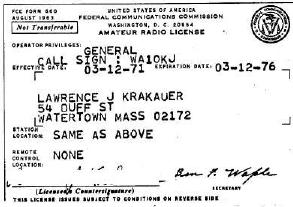 I was a licensed radio amateur through the sixties, holding the U.S. call sign WA2IHH (in the New York region, region "2"). Renewing my license in 1971 at a new home address, I was issued a call sign in the New England region (code "1"), changing my call to WA1OKJ. My second FCC ("Federal Communications Commission") license is shown to the left, except I blotted out my signature, which I don't think I should post on the web. As I began to raise a family, I eventually allowed my license to lapse due to inactivity.
I was a licensed radio amateur through the sixties, holding the U.S. call sign WA2IHH (in the New York region, region "2"). Renewing my license in 1971 at a new home address, I was issued a call sign in the New England region (code "1"), changing my call to WA1OKJ. My second FCC ("Federal Communications Commission") license is shown to the left, except I blotted out my signature, which I don't think I should post on the web. As I began to raise a family, I eventually allowed my license to lapse due to inactivity.
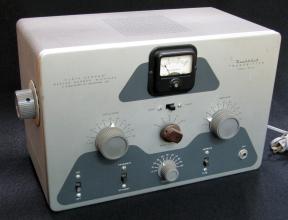
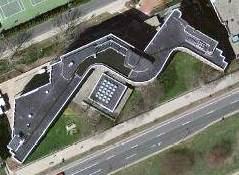 I purchased a Hallicrafters SX-100 short-wave receiver, and set it up with the DX-20 in my dormitory room in MIT's Baker House, a well-known building designed in 1947 by Finnish architect Alvar Aalto. I've shown it to the left in an overhead satellite view, so that you can see that it's a curved building. My dormitory room was in the western indentation (the left-hand side in the photo), across which I had strung a long dipole antenna. It was fed by a coaxial cable that ran from my window to the center of the antenna.
I purchased a Hallicrafters SX-100 short-wave receiver, and set it up with the DX-20 in my dormitory room in MIT's Baker House, a well-known building designed in 1947 by Finnish architect Alvar Aalto. I've shown it to the left in an overhead satellite view, so that you can see that it's a curved building. My dormitory room was in the western indentation (the left-hand side in the photo), across which I had strung a long dipole antenna. It was fed by a coaxial cable that ran from my window to the center of the antenna.
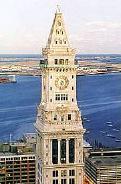 The rules for the Novice class license have changed over time, but when I held one, it was valid for only one year, and could not be renewed. The idea was to move you up to a higher class of license, in particular the "General" class. Many applicants for the "General" class had a hard time with the written test on radio theory, but as an electrical engineering student and long-time electronics hobbyist, I had no problem with that part of the requirements. I had a lot more difficulty getting my Morse code speed up to the 13 words per minute required at the
time.
The rules for the Novice class license have changed over time, but when I held one, it was valid for only one year, and could not be renewed. The idea was to move you up to a higher class of license, in particular the "General" class. Many applicants for the "General" class had a hard time with the written test on radio theory, but as an electrical engineering student and long-time electronics hobbyist, I had no problem with that part of the requirements. I had a lot more difficulty getting my Morse code speed up to the 13 words per minute required at the
time.